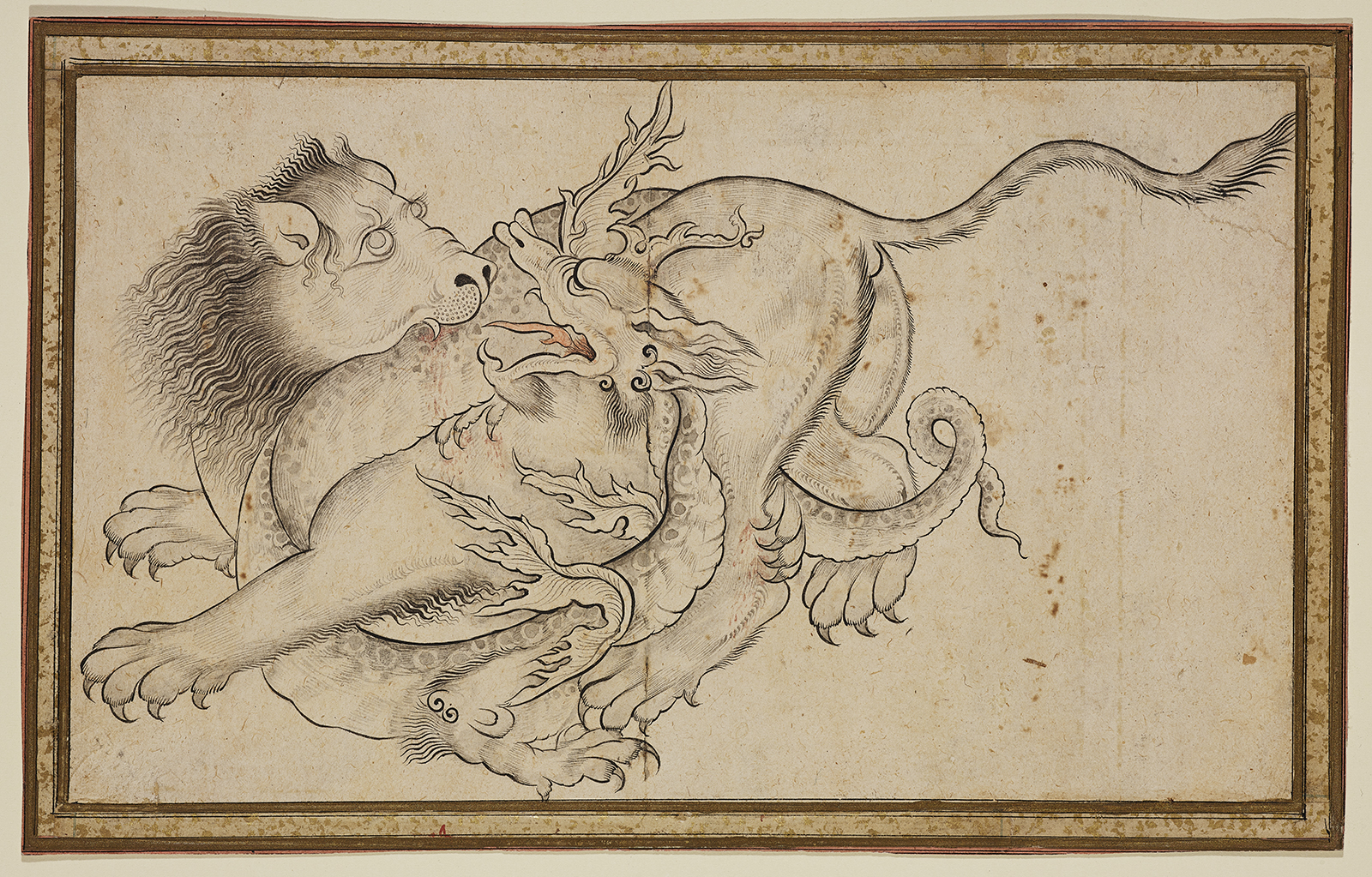Click on the image to zoom
Struggle of a Lion and a Dragon
- Accession Number:AKM82
- Place:Iran, Isfahan
- Dimensions:35.6 x 45.5 cm
- Date:ca. 1650
- Materials and Technique:Ink and gold on paper
This single-page drawing exemplifies a life-and-death struggle between a lion and a dragon. The dynamic motion and violence of the scene make it difficult to differentiate the two animals’ bodies. After the accession of the Timurids (1370-1507), whose Central Asiatic place of origin was so geographically close to Chinese culture, dynamic compositions such as a combat between two wild beasts became very popular. Mythological, fanciful creatures like the simurgh (bird), azhdar (dragon), hizarb (lion), kylin, and guardian bovine [1] were popular in Iranian painting from the 15th century onward, and shown in a large variety of fighting scenes. The depiction of dragons arrived in Iran partly by way of designs on textiles and ceramics imported from China, particularly from the 13th to the 17th centuries. [2]
Further Reading
The Qanun as-suwar (Canon of Painting, 1576–1602) of Sadeqi Beg (1533–1610),[3] artist and art theorist, gives numerous pieces of technical advice to the illustrator.[4] His guidance through techniques and recipes was useful for artists. Sadeqi Beg refers to two different main categories of pictorial art. The first is surat gari (human representation) and the second is janvar sazi (animal representation). According to Sadeqi Beg’s description, the second category, animal representation, is mainly executed in the siyah qalam (black-pen) technique.[5]
Sadeqi’s advice in three steps for the composition of fighting animal pairs is as follows: first, to achieve the best representation of animals locked in battle or what Sadeqi Beg calls “give and take” (girift-o gir), the animals must not show any bodily slackness. Second, shanks and hooves or paws must be drawn out and both bodies must be clearly visible. Third, identical patterns must be avoided to maintain originality.[6]
The creator of this particular drawing has followed Sadeqi’s advice and has drawn an exceptionally dramatic combat. Both bodies are easily distinguishable. The scene’s dynamic focus is the lion sinking its teeth into the dragon’s back. Animal fights symbolized power, and the dragon and lion, locked in savage battle, became eternal mortal enemies in Iranian art. [7] Their depiction has a long tradition as a decorative motif symbolizing good and evil, even until early modern times.
Seventeenth-century artist Mu‘in Musavvir, Reza-e ‘Abbasi’s most gifted student and well-known through the detailed information in the inscriptions on his works, made numerous drawings of a lion and a dragon attacking a man. He may have executed this drawing, which was most likely the inspiration for a work now in The Metropolitan Museum of Art by early Qajar artist Muhammad Baqer. It is a signed album leaf with an almost identical scene, dated in the second half of the 18th century,[8] nearly a century after this drawing. The drawings are similar, but the different techniques used in their creation. Their differences reflect the distinct developments of Persian painting in the 17th and 18th centuries.
Mu‘in Musavvir was famous for his draftsmanship. One of the topics of his miniature paintings and single-page drawings was animals executed with journalistic observation skills. Drawing wild and exotic animals was in no way unusual at that time, since Safavid rulers showed great interest in them.[9] In the 17th century it became quite popular to sign and date drawings, especially when the demand for signed pages rose on the market. Both Reza-e ‘Abbasi and Mu‘in Musavvir signed their drawings, and included much information.
— Filiz Çakır Phillip
Notes
[1] Martin Bernard Dickson and Stuart Cary Welch, eds., The Houghton Shahnameh, vol. 1 (Boston: Fogg Art Museum, Harvard University, 1981), 265.
[2] Norah M. Titley, Dragons in Persian, Mughal and Turkish Art (London: The British Library, 1981), 3.
[3] Abolala Soudavar, “Le Chant du Monde: A Disenchanting Echo of Safavid Art History,” Iran 46 (2008): 270; Ekhtiar et al., 224.
[4] Musee d’art et d’histoire, Jean Pozzi Collection, Geneva, Inv. 1971-107/55. See also B.W. Robinson et al., L’orient d’un collectionneur: minatures persanes, textiles, céramiques, orfevrerie reassembles par Jean Pozzi (Geneva: Musée d’art et d’histoire, 1992), 130, 263, fig. 128.
[5] Anthony Welch, Collection of Islamic Art: Prince Sadruddin Aga Khan, vol. 3 (Geneva: Château de Bellerive, 1978), 124; Sheila Canby, The Rebellious Reformer: The Drawings and Paintings of Riza-yi Abbasi of Isfahan (London: Azimuth Editions, 1996), 89.
[6] Martin Bernard Dickson and Stuart Cary Welch, eds., The Houghton Shahnameh, vol. 1 (Boston: Fogg Art Museum, Harvard University, 1981), 265.
[7] Norah M. Titley, Dragons in Persian, Mughal and Turkish Art (London: The British Library, 1981), 4.
[8 The Metropolitan Museum of Art, New York, Acc. No. 1974.20; Massumeh Farhad, “The Art of Mu‘in Musavvir: A Mirror of His Times,” in Persian Masters: Five Centuries of Painting, ed. Sheila Canby (Mumbai: Marg Publications, 1990), 119–21; Ekhtiar et al., 276.
[9] Massumeh Farhad, “An Artist’s Impression: Mu‘in Musavvir’s ‘Tiger Attacking a Youth,’” Muqarnas 9 (1992): 118.
References
Canby, Sheila. The Rebellious Reformer: The Drawings and Paintings of Riza-yi Abbasi of Isfahan. London: Azimuth Editions, 1996. https://doi.org/10.1017/S0026318400035744
Dickson, Martin Bernard, and Stuart Cary Welch, eds. The Houghton Shahnameh, vols. 1 and 2. Boston: Fogg Art Museum, Harvard University, 1981. http://www.worldcat.org/oclc/8238547
Farhad, Massumeh. “The Art of Mu‘in Musavvir: A Mirror of His Times.” In Persian Masters: Five Centuries of Painting, ed. Sheila Canby. Mumbai: Marg Publications, 1990, 113–28. ISBN: 9788185026107
Phillip, Filiz Çakır. Enchanted lines: drawings from the Aga Khan Museum collection. 2014. ISBN: 9780991992874
Soudavar, Abolala. “Le Chant du Monde: A Disenchanting Echo of Safavid Art History.” Iran 46 (2008): 253–76. https://doi.org/10.1080/05786967.2008.11864747
Titley, Norah M. Dragons in Persian, Mughal and Turkish Art. London: The British Library, 1981. ISBN: 9780904654707
Welch, Anthony. Collection of Islamic Art: Prince Sadruddin Aga Khan, vols. 1 and 3. Geneva: Château de Bellerive, 1972–78.
Note: This online resource is reviewed and updated on an ongoing basis. We are committed to improving this information and will revise and update knowledge about this object as it becomes available.


